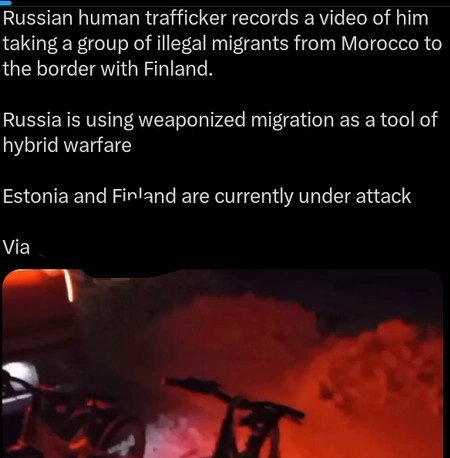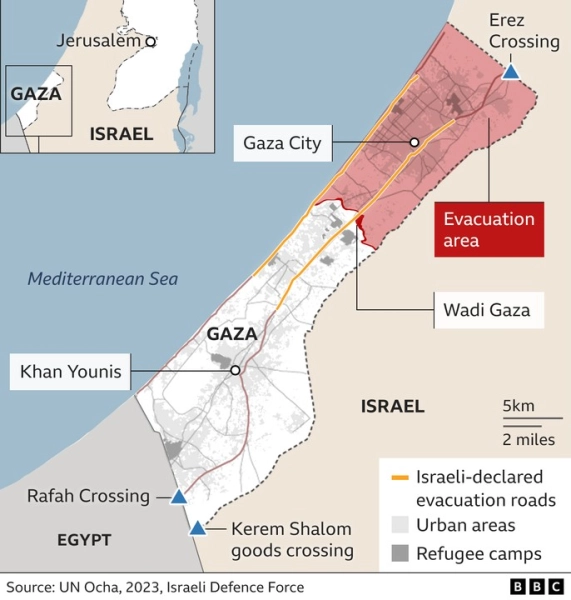profile/9802llo_20230401_103510.png.webp
Lele

Russia Using 'hybrid Warfare' Tactics To Push Migrants Over Finnish Border. - Foreign Affairs
~2.9 mins read

There has been a sharp uptick in recent days in the numbers of asylum seekers arriving at border posts in southeast Finland, after a gradual buildup over several months.
Russia is using a "hybrid warfare" tactic to push migrants over the Finnish border, sparking concerns the Kremlin might be starting a larger-scale effort to put pressure on the EU's longest border with Russia, and NATO's new eastern flank.
The Finnish Border Guard says there has been an increase in the number of people crossing from Russia into southeast Finland in recent months without proper documents – most of them lacking visas.
"The amount is higher than usual," the Border Guard said in a press release, noting that those who entered into the Nordic nation via this route have applied for asylum.
Although overall numbers are still low it still represents a sharp uptick in a relatively short period of time. Some 91 people arrived since the end of August until the weekend, while on Monday the Border Guard said 39 more people arrived, and Finnish media reported more than 50 arrived at one specific border crossing on Monday, many of them on brand new bicycles.
The Border Guard says the migrants are mostly Iraqis, Syrians, Turks and Somalis.
Previously, Russian authorities have not allowed anyone to travel to Finnish border crossing points if they don't have the correct documents or a visa, but that tactic has now changed.
"In recent months, the actions of the Russian authorities, at least on the border with southeastern Finland, have changed in such a way that, unlike before, they have allowed travel despite lack of documents," the Border Guard said.
Finnish Defense Minister Antti Häkkänen accused Russia of deliberately ushering migrants toward the border zone as a type of "hybrid warfare," and said he will inform NATO Secretary General Jens Stoltenberg and the EU about the situation.
Previous Russian tactic using migrants
Finnish authorities have been aware that Russia could send more migrants over its longest land border with the EU as part of a hybrid tactic to try and overwhelm the Finns – a tactic Moscow has tried before.
In January and February 2016, almost 1,000 migrants arrived at an Arctic border post between Finland and Russia. Finnish officials believe the arrivals were facilitated by Russian authorities with bus transport and hotel accommodation on their journey north, with people given instructions to claim asylum once they got over the border.
The event was widely considered to be Russia’s first, and most successful, hybrid attack of this type on an EU member state to date – although Finnish officials and politicians baulked at labelling it as such at the time.
Analysts tell Euronews it was likely a "proof of concept" operation, demonstrating that Russia could initiate this flow of migrants and then close it again at will.
Finland's Prime Minister Petteri Orpo says the matter "must be taken seriously", and his government is planning to announce new restrictions for the border.
Measures available to them include further restrictions of cross-border traffic, or closing the border points completely. The government could also decide to centralise all asylum applications at one specific border crossing.
"The Government will ensure Finland's border security in all situations," said Interior Minister Mari Rantanen from the far-right Finns Party. "If necessary, the Government is prepared to exercise all its powers under the law in situations that seriously endanger border security."
There are already plans in place to build a 200-kilometre fence with enhanced electronic surveillance equipment along the border, but only smaller parts have been completed so far.
"It seems that this is enabled by the Russian authorities, because the procedure deviates from what are the agreed practices at the border," Orpo told reporters on Tuesday in Helsinki.
However, the prime minister wouldn't be drawn on whether this could be classed as a case of hybrid influence.
profile/9802llo_20230401_103510.png.webp
Lele

Fuel Finally Returns To Gaza After Israeli War Cabinet Decision - Foreign Affairs
~2.1 mins read
The first delivery of fuel arrived in Gaza Friday after Israel’s war cabinet bowed to diplomatic pressure to let diesel back into the war-torn Palestinian territory, where aid schemes are shut down amid critical shortages.
As fighting between Israel and Gaza’s Hamas rulers rages for six weeks, the United Nations has warned hospitals, drinking water and sewage facilities are grinding to a halt as fuel reserves run dry.
Tzachi Hanegbi, national security adviser to Prime Minister Benjamin Netanyahu, said Israel’s war cabinet agreed “to provide two tankers of fuel a day” after a “special request” from Washington.
Hanegbi said the fuel would be used to “operate the sewage and water systems run by UNRWA”, the UN agency for Palestinian refugees.
“We took that decision to prevent the spread of epidemics. We don’t need epidemics that will harm civilians or our fighters. If there are epidemics, the fighting will stop,” he said.
Late Friday, a Palestinian border official said the first shipment of 17,000 litres of fuel had entered through the Rafah crossing with Egypt.
The official said it was “for the telecommunications company” Paltel, to ease a Gaza-wide communications blackout after the firm ran out of fuel on Thursday.
A senior US official said Washington had put huge pressure on Israel to ease its fuel blockade and avert a humanitarian catastrophe in Gaza.
The US official said that some 70,000 litres will enter daily under the deal, but UN humanitarian chief Martin Griffiths said Friday the territory needs 200,000 litres a day.
‘500 trucks’
Israel cut off all fuel supplies to Gaza after October 7, when Hamas militants surged over the border and killed 1,200 – mostly civilians – according to Israel.
In retaliation, Israel launched bombardments and a ground offensive against Hamas in Gaza, where the Islamist movement says 12,000 people, mostly civilians, have been killed.
This week Israel allowed a first shipment for UNRWA’s delivery trucks, but the agency said drivers did not have enough fuel to reach the border and fill their tanks.
Elad Goren, spokesman for COGAT, the Israeli defence ministry body responsible for Palestinian civilian affairs, accused Hamas of “exaggerating fuel shortages, especially at the hospitals”.
Earlier this week, UNRWA said 70 per cent of Gaza’s population of 2.4 million people no longer had access to clean water in southern Gaza, where raw sewage had started to flow on the streets as pumps shut down.
UNRWA’s Gaza director Thomas White said aid operations were “being strangled of resources to serve people in need”.
But Goren said Israel would not limit aid deliveries. “We are getting a list from the UN. We are not limiting the number. If tomorrow they will give us a list of 500 trucks 500 trucks will move,” he said.
Advertisement

Link socials
Matches
Loading...
